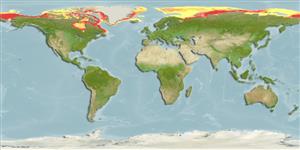Environment: milieu / climate zone / depth range / distribution range
Ecology
Marine; brackish; demersal; depth range 0 - 620 m (Ref. 58426), usually 0 - 100 m (Ref. 9926). Polar; 84°N - 51°N, 180°W - 180°E
Arctic to Northwest Atlantic: Bering Strait to Labrador in Canada. Also found in the estuary of the St. Lawrence River in Canada (Ref. 4926).
Size / Weight / Age
Maturity: Lm ? range ? - ? cm
Max length : 16.0 cm TL male/unsexed; (Ref. 7251)
Commonly lives in large clusters of kelp (Ref. 7251). It prefers bottom types like pebbles, stones or boulders, mud and sand (Ref. 5951). Benthic species. Feeds on crustaceans (Ref. 58426); especially amphipods (Ref. 5951).
Life cycle and mating behavior
Maturities | Reproduction | Spawnings | Egg(s) | Fecundities | Larvae
Robins, C.R. and G.C. Ray, 1986. A field guide to Atlantic coast fishes of North America. Houghton Mifflin Company, Boston, U.S.A. 354 p. (Ref. 7251)
IUCN Red List Status (Ref. 130435)
Threat to humans
Harmless
Human uses
Tools
Special reports
Download XML
Internet sources
Estimates based on models
Preferred temperature (Ref.
123201): -1.8 - 0.8, mean -1.2 °C (based on 6424 cells).
Phylogenetic diversity index (Ref.
82804): PD
50 = 0.5000 [Uniqueness, from 0.5 = low to 2.0 = high].
Bayesian length-weight: a=0.01122 (0.00557 - 0.02258), b=3.07 (2.89 - 3.25), in cm total length, based on LWR estimates for this species & (Sub)family-body (Ref.
93245).
Trophic level (Ref.
69278): 3.5 ±0.50 se; based on food items.
Resilience (Ref.
120179): Medium, minimum population doubling time 1.4 - 4.4 years (Assuming tmax=3-10).
Fishing Vulnerability (Ref.
59153): Low vulnerability (10 of 100).
